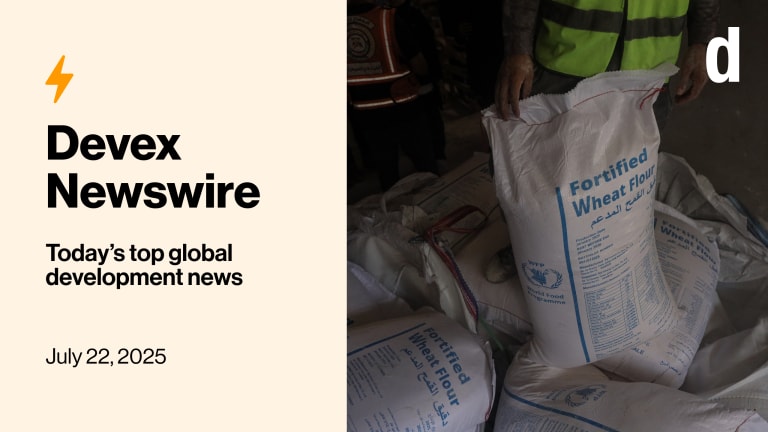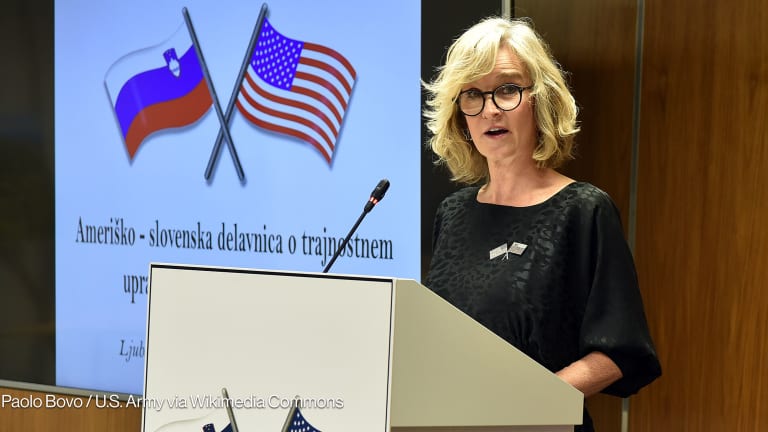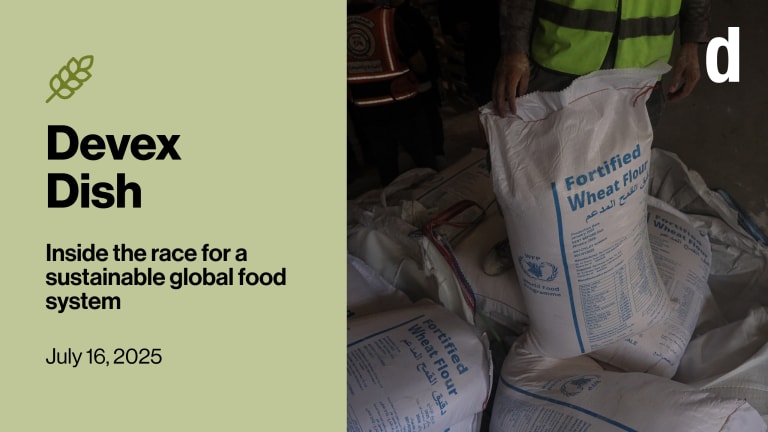
Greetings, Newswire readers! Devex’s newsroom is on a weeklong summer hiatus, so instead of the regular Newswire, we are bringing you deep dives into some of this year’s key development issues — chief among them, the remaking of U.S. foreign aid.
In this edition, we explore the changing face of U.S. food and agricultural assistance. It’s been a hectic year so far — which in some ways could be the understatement of the year. Long-running programs that enjoyed bipartisan support, such as Food for Peace Title II, face much smaller budgets and an uncertain future, while others, such as Feed the Future, have been entirely slashed by the Trump administration.
As it stands, some U.S.-funded emergency and in-kind food aid will remain, but most long-term agricultural development and innovation work funded by the U.S. will likely be no more. That’s a big deal considering that the U.S. has long been the world’s biggest funder of food and agricultural assistance.
“We know what happens when the U.S. and other developed countries disinvest in ag development,” said Stephanie Mercier, senior policy adviser at the Washington-based Farm Journal Foundation, at a recent Devex Pro event. “That’s what happened in 2007, 2008 when we had a huge spike in global prices, and it adversely affected those people in developing countries that had seen the slowest growth in ag productivity.”
The U.S. cuts come as global rates of hunger were just starting to improve in the aftermath of the COVID-19 pandemic, when they rose and remained stagnant for several years. A major United Nations report last week attributed those improvements — while uneven across regions — to investments in social protection programs such as cash transfers and universal school meals, along with agricultural productivity and efficiency.
Going forward, we’re keeping an eye on the status of various aid programs. For now, here’s a look at what’s happened so far this year and a glimpse at what’s next.
Read: The number of hungry people worldwide is falling, says UN report
Plus: A successful US food aid program needs agriculture investment, experts say (Pro)
+ Not yet a Devex Pro member? Start your 15-day free trial today to access all our expert analyses, insider insights, career resources, exclusive events, and more. Check out all the exclusive content available to you.
A deadlier world with far less food aid
In March, a study published in the journal Nature by a group of nutrition experts attempted to quantify the effects of the cuts to international food aid.
Their conclusions were sobering. They found that the dismantling of the U.S. Agency for International Development, along with aid cuts by other Western donors — including the United Kingdom, France, the Netherlands, and Belgium — were equivalent to 44% of the $1.6 billion in global donor aid for nutrition provided in 2022. The estimated funding reductions will cut off treatment for 2.3 million children in low- and middle-income countries, leading to 369,000 additional child deaths per year.
More than 163,000 of those deaths will be linked to U.S. aid reductions alone — and this may be an underestimate, the experts warned.
Perhaps no single product better illustrates the consequences of these cuts than ready-to-use therapeutic food, or RUTF — the peanut-based paste used to treat severely malnourished children. With around half the global supply manufactured in the U.S., these packets are among the most effective interventions in humanitarian nutrition, designed for rapid deployment in emergencies. Yet recent months have brought reports of RUTF shipments stuck in warehouses, orders delayed, and payments frozen, leaving vital lifesaving supplies essential to the prevention of severe hunger and famine in limbo.
The effects extend beyond treatment. The brief suspension of USAID operations in January exposed a critical vulnerability in the global system for tracking hunger when FEWS NET, USAID’s famine early-warning system, went offline. While it has resumed work, the broader infrastructure it supports remains on shaky ground. The Integrated Food Security Phase Classification, or IPC — the main classification system for food insecurity — does not collect its own data but instead depends on a network of partner organizations, many of which are now facing steep funding shortfalls because of U.S. aid cuts.
Groups such as Action Against Hunger, the U.N.’s Food and Agriculture Organization, and Oxfam conduct the household surveys and market assessments that underpin IPC analyses. Without sustained funding, especially in hard-to-reach or conflict-affected regions, their ability to produce timely, reliable data is increasingly compromised. FAO’s Data in Emergencies Hub, a key source of IPC inputs, has already halted operations in most countries due to its reliance on U.S. funding, according to a source familiar with the matter.
Read: Why are 400,000 boxes of food for malnourished kids stuck in the US?
Read more: FEWS NET, once USAID’s flagship famine warning system, is back online
Plus: After decades of progress, USAID cuts could blind the world to famine
Funding crises and grim calculus
FAO’s data funding crisis is just one part of a much wider unraveling. FAO — a central partner in the global fight against hunger and famine — is also facing funding cuts that threaten multiple areas of its work.
The U.S., its largest donor, accounted for 14% of FAO’s total resources in 2024. But earlier this year, FAO received termination notices for more than 100 U.S.-funded programs valued at approximately $348 million. Among the hardest hit was its global health security program, which works to prevent the spread of transboundary animal diseases such as bird flu, New World screwworm, and African swine fever across 49 countries. That program has been forced to scale back significantly after losing 90% of its funding — nearly all of it from the U.S. While 34 Pandemic Fund projects are still active, the widespread cuts have exposed just how reliant the agency had become on American support.
Furthermore, funding for the World Food Programme — the world’s largest humanitarian organization and likewise heavily reliant on U.S. funding — has also been severely affected. In April, WFP announced it would cut 25% to 30% of its global workforce, impacting up to 6,000 roles, as it braces for 2026 staffing and funding constraints.
These layoffs compound an already dire funding shortfall. In 2024, WFP sought $21.1 billion to support 150 million people but received just $9.75 billion — less than half its target. Although slightly better than 2023’s performance ($8.3 billion raised out of a $23.5 billion goal), the funding remains well below WFP’s typical target fulfillment rate of around 60%.
“Food is amongst those things that you have to have every day. It's not a one-time vaccination. Therefore, the need for that regular funding is just so critical,” Manoj Juneja, who was WFP’s chief financial officer for a decade before his retirement in 2023, told Devex in an interview. The lack of funding is forcing organizations to make impossible decisions about who gets food and who doesn’t. At one point, WFP said the canceled programs “could amount to a death sentence for millions of people facing extreme hunger and starvation.”
WFP’s chief economist, Arif Husain, had summed up the grim calculus to Devex: “It’s not like there is a big difference between haves and have-nots … it’s barely any difference. We have to play God.”
Other food-related U.N. agencies are scrambling to adapt. The International Fund for Agricultural Development, or IFAD, which had to navigate similar U.S. funding cuts during President Donald Trump’s first term, has spent recent years experimenting with innovative financing — such as expanding mechanisms to channel remittances more effectively. These kinds of creative approaches are increasingly being touted as potential lifelines for agencies struggling to stay afloat without reliable U.S. support.
Yet uncertainty looms large over how these agencies will operate moving forward — particularly under Lynda Blanchard, Trump’s pick to oversee U.S. engagement with the Rome‑based U.N. food agencies. A self-described “Christian conservative,” “business builder,” and “proud member of the MAGA movement,” Blanchard made her political stance clear at her confirmation hearing: “As we all know, food security is bipartisan. We’re all in agreement of that,” she told Sen. Cory Booker, a Democrat from New Jersey. “But I do think we are in agreement, as well, for accountability of our checkbooks.”
Read: UN food agency caught in Trump administration’s crosshairs
Exclusive: WFP to cut up to 30% of staff amid aid shortfall
ICYMI: IFAD looks beyond US aid, and toward catalytic solutions
Know more: Who is Lynda Blanchard, Trump’s pick for the top UN food agencies post?
What’s next?
It’s not just aid recipients abroad who stand to suffer as a result of the cuts. Those cuts could hurt American farmers and consumers in the end, too. That argument is increasingly being made in Congress as various groups lobby to restore and save U.S. food aid.
“USAID procured nearly $2 billion from American producers and shippers,” representing a significant, stable market for U.S. agricultural goods, said Sen. Amy Klobuchar, a Democrat from Minnesota, at a forum of agriculture and aid experts on Capitol Hill in June. Without that outlet, farmers are in the line of fire.
“You are hit right now by so many headwinds,” Klobuchar said, listing tariffs and market volatility, “that you are about to become roadkill for this administration’s policy.”
Meanwhile, as traditional foreign food aid budgets are slashed, cash assistance — used to help people buy food locally and support markets — is getting renewed attention. It’s cost-effective, adaptable, and preferred by recipients. Yet despite years of evidence supporting its use, cash programming is again under threat, as donors, including but not limited to the U.S., slash aid. In an era of austerity, advocates argue that cutting cash assistance makes little sense — especially when it's one of the few tools that can stretch limited resources and still meet food needs at scale.
“We are at a critical juncture” for cash programming, said Cate Turton, director of the CALP Network, whose 90-plus members believe cash and vouchers are the best way to help people in crises.
But when it comes to what remains of U.S. food aid, maintaining some programming, such as emergency food for crises, while cutting longer-term agricultural investment, is a bit like keeping the wing of a plane and getting rid of the rest, said Dina Esposito, a former USAID assistant administrator who headed the Bureau for Resilience and Food Security, during a Devex Pro event last month.
“It doesn’t fly if you don’t include all the parts.”
Read: US farmers ‘about to become roadkill’ under Trump food aid cuts, senators warn
Plus: Amid aid cuts, the future of cash programming hangs in the balance
+ For more in-depth content like this, sign up to Devex Dish — our free, weekly newsletter that delivers insights on the global food system.









